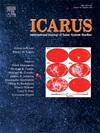Lunar volcanic gas cloud chemistry: Constraints from glass bead surface sublimates
IF 2.5
2区 物理与天体物理
Q2 ASTRONOMY & ASTROPHYSICS
引用次数: 0
Abstract
Lunar pyroclastic glass beads preserve a record of physical and chemical conditions within volcanic gas clouds in the form of nanoscale minerals vapour-deposited onto their surfaces. However, the scale of these mineral deposits - less than 100 nm - has presented challenges for detailed analysis. Using SEM, TEM, APT, and NanoSIMS, we analysed pristine black glass beads from Apollo drive tube 74001 and found a sequence of sulfide deposition that directly evidences lunar gas cloud evolution. The deposits are predominantly micromound structures of nanopolycrystalline sphalerite ((Zn,Fe)S), with iron enrichment at the bead-micromound interface. Thermochemical modelling indicates that hydrogen and sulfur were major elements within the volcanic plume and ties the iron gradient to decreasing gas pressure during deposition. This pressure drop may also be consistent with our observed trend of potential depletion. Finally, Apollo 17 74220 orange beads, deposited higher in the Shorty Crater sequence, appear to lack abundant ZnS nanocrystals (Liu and Ma, 2024a), suggesting a change in vapour deposition between orange- and black-glass bead deposition. Together, our results suggest a change in eruption style over the course of a pyroclastic volcanic eruption in the Taurus-Littrow Valley.
月球火山气体云化学:玻璃珠表面升华的约束
月球火山碎屑玻璃珠以纳米级矿物蒸汽沉积在其表面的形式保存了火山气体云内物理和化学条件的记录。然而,这些矿床的规模小于100纳米,这给详细分析带来了挑战。通过SEM、TEM、APT和NanoSIMS,我们分析了来自阿波罗74001驱动管的原始黑色玻璃珠,发现了硫化物沉积序列,直接证明了月球气体云的演化。矿床以纳米多晶闪锌矿((Zn,Fe)S)微丘结构为主,铁富集于晶珠-微丘界面。热化学模拟表明,氢和硫是火山柱中的主要元素,并将铁梯度与沉积过程中气体压力的下降联系起来。这种压降也可能与我们观测到的δ34S耗减趋势相一致。最后,阿波罗17号74220橙色珠,沉积在Shorty陨石坑序列的较高位置,似乎缺乏丰富的ZnS纳米晶体(Liu和Ma, 2024a),表明在橙色和黑色玻璃珠沉积之间的气相沉积发生了变化。总之,我们的结果表明,在金牛座-利特罗山谷的火山碎屑火山喷发过程中,喷发风格发生了变化。
本文章由计算机程序翻译,如有差异,请以英文原文为准。
求助全文
约1分钟内获得全文
求助全文
来源期刊

Icarus
地学天文-天文与天体物理
CiteScore
6.30
自引率
18.80%
发文量
356
审稿时长
2-4 weeks
期刊介绍:
Icarus is devoted to the publication of original contributions in the field of Solar System studies. Manuscripts reporting the results of new research - observational, experimental, or theoretical - concerning the astronomy, geology, meteorology, physics, chemistry, biology, and other scientific aspects of our Solar System or extrasolar systems are welcome. The journal generally does not publish papers devoted exclusively to the Sun, the Earth, celestial mechanics, meteoritics, or astrophysics. Icarus does not publish papers that provide "improved" versions of Bode''s law, or other numerical relations, without a sound physical basis. Icarus does not publish meeting announcements or general notices. Reviews, historical papers, and manuscripts describing spacecraft instrumentation may be considered, but only with prior approval of the editor. An entire issue of the journal is occasionally devoted to a single subject, usually arising from a conference on the same topic. The language of publication is English. American or British usage is accepted, but not a mixture of these.
 求助内容:
求助内容: 应助结果提醒方式:
应助结果提醒方式:


